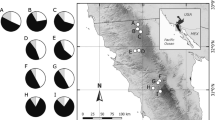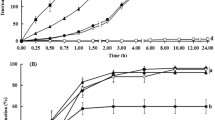Summary
Vincetoxicum hirundinaria is a longlived perennial herb. Its pod production was measured during seven years in about 40 small isolated patches in two study areas in southeastern Sweden. Total pod production in the two areas varied synchronously and up to about 200 times between years. This variation was mainly due to drought conditions as determined by the interplay of weather (sunshine h) and site characteristics.
Populations of a univoltine tephritid fly, euphranta connexa, whose larva feeds on V. hirundinaria seeds in the maturing pods, were monitored for five and seven years in the two study areas respectively. Larval fly populations in the two areas varied 30 and 50-fold between years, with highs in years when pods were abundant and lows when pods were scarce. The percentage of pods attacked by E. connexa, however, varied in the opposite direction, with very high attack rates (about 100%) when pods were scarce and low rates (down to 10–20%) when pods were common. Thus the temporal tracking of food resources by E. connexa was poor, resulting in yearly variations in the amount of unattacked pods (and seeds) being about 2,00-fold.
Many host plant patches were small and totally without pods in some years, causing frequent local extinctions of E. connexa. Patches were, however, readily colonized in later years when pods appeared again. Low overall attack rates in certain years were thus only to a minor extent explainable by host plant patches being uncolonized by the fly. The efficient spatial tracking of resources by the fly population allows this population system to be analyzed largely in terms of its temporal dynamics.
Although E. connexa populations often exploit only a minor part of their potential larval resources, the rate of population change was closely correlated with these resources expressed on a per capita basis. Natural enemies only have negligible effects on E. connexa population trends. In this population system the herbivore (seed predator) population is thus controlled by its food resources, but weather-imposed temporal variations in resource set are too large for the herbivore population to closely track its resource base. This temporal tracking inertia has important implications for the long-term production of healthy seeds.
Similar content being viewed by others
References
Almquist E (1965) Flora Upsaliensis. Uppsalatraktens växter. Almqvist & Wiksell, Stockholm Göteborg Uppsala
Andrewartha HG, Birch LC (1954) The distribution and abundance of animals. The University of Chicago Press, Chicago, p 782
Arvidsson I (1951) Austrocknungs- und Dürreresistenzverhältnisse ciniger Repräsentanten öländischer Pflanzenvereine nebst Bemerkungen über Wasserabsorption durch oberirdische Organe. Oikos, Suppl 1:1–181
Aubert JF (1969) Les Ichneumonoides ouest-paléarctiques et leurs hôtes. 1. Pimplinae, Xoridinae, Acaentinae. Editeur Quatre-Feuilles, Alfortville, p 302
Bateman MA (1972) The ecology of fruit flies. Ann Rev Entomol 17:493–518
Caswell H (1978) Predator-mediated coexistence: A nonequilibrium model. Am Nat 112:127–154
Caughley G, Lawton JH (1981) Plant — herbivore systems. In: May RM (ed) Theoretical ecology. Principles and applications. 2nd ed, Blackwell Scientific Publications, Oxford, pp 132–166
Christenson LD, Foote RH (1960) Biology of fruit flies. Ann Rev Entomol 5:171–192
Clark LR, Geier PW, Hughes RD, Morris RF (1967) The ecology of insect populations in theory and practice. Methuen, London, p 232
Connell JH (1979) Tropical rain forests and coral reefs as open non-equilibrium systems. In: Andersson RM, Turner BD, Taylor LR (eds) Population dynamics. Blackwell Scientific Publications, Oxford, pp 141–163
Crawley MJ (1983) Herbivory. The dynamics of animal — plant interactions. Studies in ecology Vol 10. Blackwell Scientific Publications, Oxford, p 437
Dempster JP, Pollard E (1981) Fluctuations in resource availability and insect populations. Oecologia (Berlin) 50:412–416
De Steven D (1983) Reproductive consequences of insect seed predation in Hamamelis virginiana. Ecology 64:89–98
Donadille P (1965) Contribution a l'étude du Vincetoxicum officinalis Moench et de ses “variétés” dans le sud-est Français. Naturalia Monspeliensia Ser Bot 16:17–42
Gustafsson B (1983) Fjärilar på Ölands Stora alvar. Entomologisk tidskrift, Stockholm 104:127–135
Harper JL (1977) Population biology of plants. Academic Press, London New York San Francisco, p 892
Hendel F (1927) 49. Trypetidae. In: Lindner E Die Fliegen der Palaearktischen Region V. E. Schweizerbart'sche Verlagsbuchhandlung, Stuttgart, p 221
Hubbell SP (1980) Seed predation and the coexistence of tree species in tropical forests. Oikos 35:214–229
Hultén E (1971) Atlas över växternas utbredning i Norden. Second ed. Generalstabens Litografiska Anstalts Förlag, Stockholm, p 531
Inghe O, Tamm CO (1985) Survival and flowering of perennial herbs. IV The behaviour of Hepatica nobilis and Sanicula europea on permanent plots during 1943–1981. Oikos 45:400–420
Janzen DH (1971) Seed predation by animals. Ann Rev Ecol Syst 2:465–492
Janzen DH (1980) Specificity of seed-attacking beetles in a Costa Rican decidous forest. J Ecol 68:929–952
Janzon L-Å (1982) Description of the egg and larva of Euphranta connexa (Fabricius) (Diptera: Tephritidae) and of the egg of its parasitoid Scambus brevicornis (Gravenhorst) (Hymenoptera: Ichneumonidae). Entomol Scand 3:313–316
Johnson CG (1969) Migration and dispersal of insects by flight. Methuen & Co Ltd, London, p 763
Knuth P (1899) Handbuch der Blütenbiologie. II Band. 2 Teil Verlag von Wilhelm Engelmann, Leipzig
Malmgren U (1982) Västmanlands flora. Stockholm, p 670
Mattson WJ (1971) Relationship between cone crop size and cone damage by insects in red pine seed-production areas. Can Entomol 103:617–621
Mattson WJ (1978) The role of insects in the dynamics of cone production of red pine. Oecologia (Berlin) 33:327–349
Price PW (1984) Alternative paradigms in community ecology. In: Price PW, Slobodchikoff CN, Gaud WS (eds) A new ecology. Novel approaches to interactive systems. John Wiley and Sons, New York, pp 353–383
Prokopy RJ (1983) Tephritid relationships with plants. In: Cavalloro R (ed) Fruit flies of economic importance. A.A. Balkema, Rotterdam, pp 230–239
Prokopy RJ, Ziegler JR, Wong TTY (1978) Deterrence of repeated oviposition by fruit-marking pheromone in Ceratitis capitata (Diptera: Tephritidae). J Chem Ecol 4:55–63
Roitberg BD, Cairl RS, Prokopy RJ (1984) Oviposition deterring pheromone influences dispersal distance in tephritid fruit flies. Entomol Exp Appl 35:217–220
Silvertown JW (1980) The evolutionary ecology of mast seeding in trees. Biol J Linn Soc 14:235–250
Solbreck C, Kugelberg O (1972) Field observations on the seasonal occurrence of Lygaeus equestris (L.) (Het., Lygaeidae) with special reference to food plant phenology. Entomol Scand 3:189–210
Solbreck C, Sillén-Tullberg B (1986) The role of variable weather for the dynamics of a seed — seed predator system. Oecologia (Berlin) 71:59–62
Sterner R (1922) The continental element in the flora of south Sweden. Geogr Ann, Stockholm 4:221–444
Strong DR, Lawton JH, Southwood TRE (1984) Insects on plants. Community patterns and mechanisms. Blackwell Scientific Publications. Oxford, p 313
Sylvén E (1983) Gallmyggor på Ölands alvar. Entomol Tidskr, Stockholm 104:136–150
Tutin TG, Heywood V-H, Burges NA, Moore CM, Valentine DH, Walters SM, Webb DA (1972) Flora Europaea, Vol 3. Cambridge University Press, Cambridge, p 385
Varley GC (1947) The natural control of population balance in the knapweed gall-fly (Urophora jaceana). J Anim Ecol 16:139–187
Wiens JA (1984) Resource systems, populations, and communities. In: Price PW, Slobodchikoff CN, Gaud WS (eds) A new ecology. Novel approaches to interactive systems. John Wiley and Sons, New York, pp 397–436
Wilbur HM (1976) Life history evolution in seven milkweeds of the genus Asclepias. J Ecol 64:223–240
Willson MF, Price PW (1980) Resource limitation of fruit and seed production in some Asclepias species. Can J Bot 58:2229–2233
Zwölfer H (1983) Life systems and strategies of resource exploitation in tephritids. In: Cavalloro R (ed) Fruit flies of economic importance. A.A. Balkema, Rotterdam 16–30
Author information
Authors and Affiliations
Rights and permissions
About this article
Cite this article
Solbreck, C., Sillén-Tullberg, B. Seed production and seed predation in a patchy and time-varying environment. Dynamics of a milkweed — tephritid fly system. Oecologia 71, 51–58 (1986). https://doi.org/10.1007/BF00377320
Received:
Issue Date:
DOI: https://doi.org/10.1007/BF00377320




